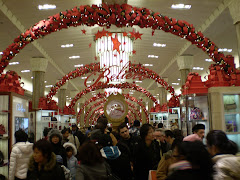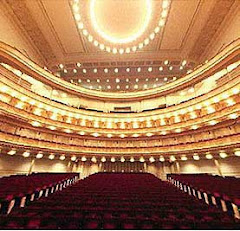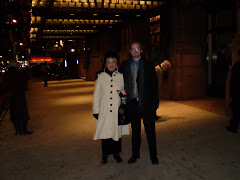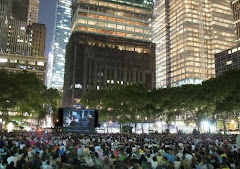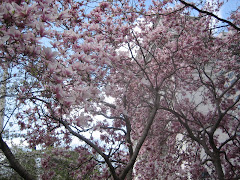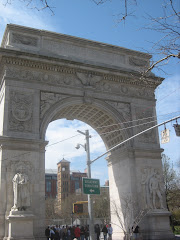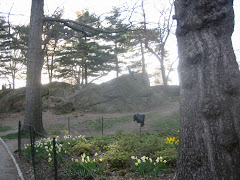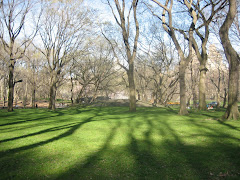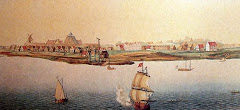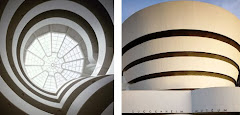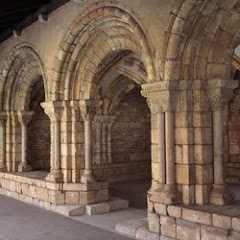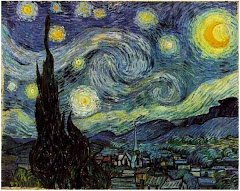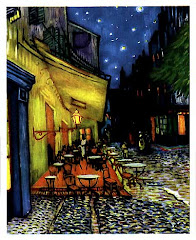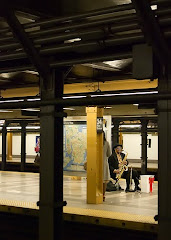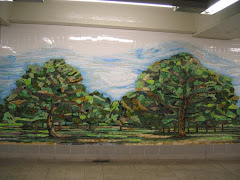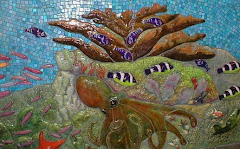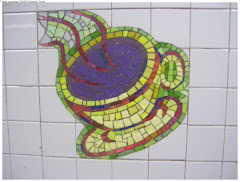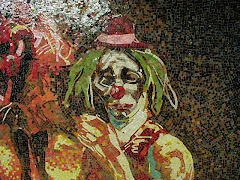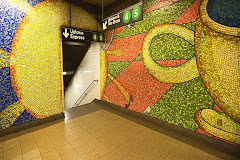With 8 million people visiting the Big Apple you might ask yourself, "Where do all those people go to attend to personal needs (use the restroom)?" Well, most public places in New York will tell you , "NOT HERE." This presents a problem to women of a certain age and I suppose men of a certain age as well. Here are some tips about places which will allow you use of their facilities. Any fast food restaurant such as McDonald's will be glad for you to use the facilities so long as you buy a drink or something small. Subways is the exception since they do not have public restrooms. Starbucks will share its facilities though you should expect a line. So will the large bookstores, Borders and Barnes and Noble. Hotels usually welcome guests though I have found one hotel near Times Square which requires a room key to use the restroom in the lobby. Woe be unto you should you take a long trip and then try to use the restroom before you check in.
If you think about it, you really can 't blame the public places for not sharing restrooms. How would you like to clean the toilet after 8 million people?
Tuesday, October 27, 2009
Other parks
There are several other parks which I enjoy. One is Prospect Park in Brooklyn, It is next to Park Slope, one of Brooklyn's elite neighborhoods. It is near an arch dedicated to Civil War Soldiers. The interesting thing is that it is dedicated to Yankee soldiers. Imagine that.
Another favorite park is called the River Park located along the West Coast of Manhattan, accessible from 59th street, around Lincoln Center. This is a favorite of mine. Willow trees abound here along with tall ornamental grasses. The view of the Hudson River soothes the soul. The ruins of a once busy railroad track and bridge remain in the river as a reminder of times past. Along a wooden deck visitors can take free yoga lessons and in the summer, free classic movies are presented at the end of the pier.
New Yorkers will turn anything into a park as evidenced by High Line Park. A freight train, which ran about 20 feet above street level, operated in the mid 20th Century. The abandoned track is now a park, with grass, trees, walkways and benches. It is very interesting to walk along this park with the city traffic drumming and honking underneath. The High Line Park is accessible from 14th and 20th street around 12th Avenue.
Another favorite park is called the River Park located along the West Coast of Manhattan, accessible from 59th street, around Lincoln Center. This is a favorite of mine. Willow trees abound here along with tall ornamental grasses. The view of the Hudson River soothes the soul. The ruins of a once busy railroad track and bridge remain in the river as a reminder of times past. Along a wooden deck visitors can take free yoga lessons and in the summer, free classic movies are presented at the end of the pier.
New Yorkers will turn anything into a park as evidenced by High Line Park. A freight train, which ran about 20 feet above street level, operated in the mid 20th Century. The abandoned track is now a park, with grass, trees, walkways and benches. It is very interesting to walk along this park with the city traffic drumming and honking underneath. The High Line Park is accessible from 14th and 20th street around 12th Avenue.
A Cemetary that was Once a Park
Greenwood Cemetery is located in Brooklyn and is one of the oldest in the country. I include it here because, it was the inspiration for the public parks. During the 19th Century, New Yorkers would hang out at the Cemetery on Sundays to take advantage of the trees and grass. Because so many were doing this, it was decided to provide open spaces without the graveyard.
Greenwood Cemetery is historic and also provides an great view of the Manhattan Skyline. I have not spent much time there but have been told it is the home of parrots.
Greenwood Cemetery is historic and also provides an great view of the Manhattan Skyline. I have not spent much time there but have been told it is the home of parrots.
What is it with New York Parks and Cemetaries
Bryant Park is next to the New York City Public Library, at 42nd and 6th Avenue. It is beautifully landscaped and probably haunted as it was once a cemetery. As with Washington Square Park, the graves were not moved when the land was transformed into a park. I believe that they were moved when the library, which could not expand beyond Fifth Avenue, expanded under Bryant Park.
The Park is the site of various entertainment venues, including the Summer Broadway Series. On Thursday's at noon, casts from several Broadway Shows perform musical numbers from the shows. This event is free of charge.
The Park is the site of various entertainment venues, including the Summer Broadway Series. On Thursday's at noon, casts from several Broadway Shows perform musical numbers from the shows. This event is free of charge.
Sunday, October 25, 2009
Washington Square Cemetary nee Park
The park I frequent most, and therefore, probably my favorite, is Washington Square Park. Washington Square was first developed to increase the areas property value of the area. Prior to being a park it was a cemetery where victims of the Yellow Fever Epidemic and indigents were buried. Those souls still enjoy the park since their bodies were never disinterred but remain buried there, which just makes the place all the more interesting and probably haunted. At the northern boundary of the park facing Waverly Street are thirteen red brick brownstones which made up some of the most fashionable homes in the early 19th Century. Right across from this, at the end of 5th Avenue is an arch, dedicated to George Washington and built to commemorate the 100th anniversary of his Inauguration. The park surrounds a fountain and plaza which is always crowded with people and performers. Under the arch you can hear a doo whap group and along the walkways a great jazz trio. Once I heard a young man and his older brother performing Michael Jackson songs and I swear I will next hear him on Broadway. None of those things recommend Washington Square so much its venue for people watching. Located in the midst of NYU and within the boundaries of Greenwich Village, it is and always has been the place to see the most interesting people. If you could travel back in time you might have seen Robert Louis Stevenson sitting on a bench with Mark Train. Louisa May Alcott wrote Little Women a block from the park. In recent history you could have seen Stanley Kubrick playing chess or Pete Seeger holding hands with his wife. Bob Dylan, first played near here. It is the scene of numerous movies including When Harry Met Sally, I am Legend, Deep Impact and August Rush as well as T.V. shows too numerous to name. (This may be why people, first visiting the park have told me that it looks familiar.) It has inspired songs by Joan Baez (Diamonds and Rust) and Counting Crows among others.
Today the young and old, rich and homeless, glamorous and gauche, poets and songwriters, artists and novelists, philosophers in deep discussion, lovers in deep amore provide a buffet better than Luby's for the people watcher.
Today the young and old, rich and homeless, glamorous and gauche, poets and songwriters, artists and novelists, philosophers in deep discussion, lovers in deep amore provide a buffet better than Luby's for the people watcher.
Tuesday, October 20, 2009
The Great Back Yard
The most famous of all New York City's parks, is Central Park. Everyone has heard of this park, everyone who has seen a movie or TV show within the last 30 years. Central Park occupies over 850 acres and is bordered by 59th street to the South and 110th to the north, making a giant rectangle in the north central part of Manhattan. Though there was originally a small village, Seneca, inhabited by Irish and black residents, most of the land was uninhabitable. Today, a walk through the park reveals giant schists or large black boulders, the remains of the receding Wisconsin Glacier. These schists are evident elsewhere in the city but nowhere as prolific as in the park. Removal of these formations made agriculture or development financially prohibitive. Today they provide seating and points of interest for park visitors. There are numerous points of interest in the park and the best way to see it is by taking a walking tour. These are provided through the park conservatory or through commercial guidebooks. One of my favorite sights is the Elm Grove which includes the "Poet's Walk" This is the largest Elm Grove in the Country. At the time when Dutch Elm Disease killed most of the elm in the United States, these elm were protected and survive today.
I have had some memorable moments in Central Park. One was last winter when it snowed. I took a lengthy walk through the park. I will let the pictures describe what words cannot.
Central park serves as a major entertainment venue. This summer I saw a production of Shakespear in the Park, Twelth Night. The production was critically acclaimed and rightly so as it rivaled any Broadway Production. There is no charge for admission but you do pay a price, having to stand in line the day of the production for four hours.
Another memorable event was the New York Philharmonic Orchestra's Summer Concert in the Park. This was also free. New Yorkers came by the thousands with their blankets and picnic baskets to sit on the lawn and listen to Beethovan and Mozart.
I have had some memorable moments in Central Park. One was last winter when it snowed. I took a lengthy walk through the park. I will let the pictures describe what words cannot.
Central park serves as a major entertainment venue. This summer I saw a production of Shakespear in the Park, Twelth Night. The production was critically acclaimed and rightly so as it rivaled any Broadway Production. There is no charge for admission but you do pay a price, having to stand in line the day of the production for four hours.
Another memorable event was the New York Philharmonic Orchestra's Summer Concert in the Park. This was also free. New Yorkers came by the thousands with their blankets and picnic baskets to sit on the lawn and listen to Beethovan and Mozart.
The great back yards.
Most New Yorker's do not have conventional back yards. Oh, there are some postage stamp green spots adjacent to some of the homes, but nothing that would qualify as a lawn back in Texas. It is interesting that many neighborhoods turn the ocassional vacant lots into gardens, with small plots for the community gardeners. These are delightful. But New Yorker's have great yards in which to play, rest and relax. Imagine if you can, yards that are always well maintained, mowed, planted with green grass and featuring a variety of trees and plants, annuals as well as evergreens. These lawns have playground equipment and frequently host parties with live entertainment venues. These are the New York City parks and it is to those I now turn my attention.
Monday, October 12, 2009
A little history, a little trivia
Enough of art. You will never understand or appreciate New York City until you know its history. NYC was founded by the Dutch and even back in the 16th Century it was noted that, at any given time, several different languages could be heard on the streets of New Amsterdam (the first name of New York). The Dutch, who settled the first colony, were a tolerant people. It is one of the traditions they brought to the New Land. In addition, the Dutch brought the tradition of free trade. One actually led to the other. If one wants free trade, one must be tolerant in order to attract many customers. These two traditions, tolerance and free trade evolved in New York (the city was renamed after the English took the colony) to become part of the new country formed by the thirteen colonies. New York remains extremely tolerant today. You will find a little of everything and everyone here and this diversity gives the city its color and spice. New York throughout history has been a major center of trade. Its importance as a trade center was evidenced by the fortifications the new country installed to protect its harbor during the war of 1812. Washington D.C. fell to the British but New York was protected by a trio of forts at Governor's Island, Clinton Castle, at Battery Park and the fort at what is now the base of the Statue of Liberty. For this reason, you can find anything your heart desires in this city. If something is made anywhere in the world and shipped to the U.S., it is for sale in New York City.
A little trivia: Yes, Manhattan was sold for wampum (beads), yes they did build a wall on what is now Wall Street (This wall was to keep out invaders, however, when Indians attacked the city, they simply walked around the wall.) Canal street was a canal that transected the Island probably used by the Natives to cross from the East to the Hudson Rivers. Pearl street was a trail where the Natives dumped oyster shells. There is no natural drinkable water in New York, as the early New Yorkers polluted all natural resources. It must all be imported from North of the city. The bread products such as the pizza dough and the bagels are believed to get their unique and highly desirable qualities from that imported water.
Why is New York called the "Big Apple." I have found there are two explanations. One has to do with horse racing. The track in horse racing was referred to as the apple. The most important races were held in New York. It was the "Big Apple." A similar explanation has to do with show business. A performance venue was call the Apple. The number one performance venue was and still is New York City, thus it is "the Big Apple." The term became really popular during an advertising campaign for New York tourism. I have been told that before it was called the Big Apple, it was called the "Big Onion." As soon as I learn why I will get back to you.
Have you ever wondered why the media gives so much attention to the Mayor of New York. The reason is simple. How many governors have such a large constituency?
Enough history for now. On to parks.
A little trivia: Yes, Manhattan was sold for wampum (beads), yes they did build a wall on what is now Wall Street (This wall was to keep out invaders, however, when Indians attacked the city, they simply walked around the wall.) Canal street was a canal that transected the Island probably used by the Natives to cross from the East to the Hudson Rivers. Pearl street was a trail where the Natives dumped oyster shells. There is no natural drinkable water in New York, as the early New Yorkers polluted all natural resources. It must all be imported from North of the city. The bread products such as the pizza dough and the bagels are believed to get their unique and highly desirable qualities from that imported water.
Why is New York called the "Big Apple." I have found there are two explanations. One has to do with horse racing. The track in horse racing was referred to as the apple. The most important races were held in New York. It was the "Big Apple." A similar explanation has to do with show business. A performance venue was call the Apple. The number one performance venue was and still is New York City, thus it is "the Big Apple." The term became really popular during an advertising campaign for New York tourism. I have been told that before it was called the Big Apple, it was called the "Big Onion." As soon as I learn why I will get back to you.
Have you ever wondered why the media gives so much attention to the Mayor of New York. The reason is simple. How many governors have such a large constituency?
Enough history for now. On to parks.
Wednesday, October 7, 2009
The other museum designed by Frank Lloyd Wright
The Guggenheim has a notable collection of Modern art and is host to many exhibitions but what appeals to me the most is not the art inside the Guggenheim but the remarkable museum building itself. It was designed fifty years ago by Frank Lloyd Wright who also designed the Kimball in Fort Worth, Texas. The main gallery spirals upward like a shell. Inside, the exhibitions in the main gallery are featured on the walls of the "shell" as it curves toward the ceiling, a glass webbed window. The art is displayed on the walls of this upward moving gallery. If you are not particularly interested in the exhibition, never fear, you will be fascinated by the view as you ascend or descend, looking down at the lobby or up to the ceiling. In other galleries you come upon interior windows which frame other interior galleries or exterior windows looking out over the exterior of the building or Central Park. The design of each space is appealing.
The Guggenheim is on 5th Avenue, a little North of the MET, across the street from Central Park. Admission is $20. On Saturday evenings after six, admission is donar's choice. There is a line.
The Guggenheim is on 5th Avenue, a little North of the MET, across the street from Central Park. Admission is $20. On Saturday evenings after six, admission is donar's choice. There is a line.
Saturday, October 3, 2009
Conquering the MET
The Metropolitan Museum of Art covers four city blocks. That is almost as large as the entire downtown area of the small town where I was reared. It is a maze of galleries and hallways, and art from every place and time on earth. It is more than my poor little ADD brain can handle. In order to "do" the MET, I have to break it down into manageable parts. I go frequently. Each time there is a featured exhibition I would like to see, or if I get wrapped up in work and forget why I live in this city, I will take the time to visit the MET.
I have been at least seven times in the thirteen months I have lived here and I have still only seen a fifth of the museum. If I am going to a special exhibit, I carefully follow the directions to navigate my way through the monstrous labyrinth. My original plan was to always explore one or two of the the permanent exhibits which I encountered on the way. In a fortunate turn of events, the area around the entrance to the museum was under construction, forcing patrons to enter from a southern entrance and take an elevator up to the main floor. This alarmed me as it is easy to get lost in this place. On the way to a Veermeer exhibition, I discovered the Greek Courtyard, a sumptuous gallery of Greek Sculpture with seating which facilitates spending enough time there to do the Greeks justice. I plan to do just that the next time I visit. Who knows when I would have found it otherwise.
You may think I am kidding about getting lost. Earlier this year, I went to see the new American Wing. There is a large section devoted to American Design which features room after room of furniture, set up as originally used, dating from pre-revolutionary time to Frank Lloyd Wright. After wandering around for some time, I found myself in an unusual space with row after row of furniture, organized not by rooms but by object. There were rows and rows of chairs, then tables, silver serving pieces, chests, all displayed in glass cases. I thought to myself, this must not be their best stuff to crowd it all together like this. Finally, I realized, I was in the storage area. Actually, this area is open to the public intentionally.
Going back to the Frank Lloyd Wright room, I loved this exhibit. If you ever wondered about Wright's contribution to modern design you will see it in this room.
The Metropolitan Museum of Art is located in Central Park and faces Fifth Avenue. The Museum is usually closed on Monday but will open if it is a holiday. The recommended donation is $20, which you should pay. If you can't afford the cost, you may make a donation of what you can afford. (No one will look askew at you for not paying the full price.)
Following your visit to the MET, plan to ride the bus down Fifth Avenue to 34th Street. (Be sure to get on the right bus because one does not go all the way down.) Along Fifth Avenue you will see penthouse apartments on one side and Central Park on the other. Then after Central Part you will see the Merchandizing Icons including: FOA Schwartz, Cartier, De Beers, Tiffany's, Gucci, Armani, Louis Vitton, Ferragami, Bergdorf Goodman, Sak's Fifth Avenue, and Lord and Taylor and too many more to name. These are the original stores and the reason women once flocked to New York to shop. (Long before the days of malls when these stores opened outlets all over the country.) At 50th street you will pass St. Patrick's Cathedral and Rockefeller Center and at 42nd the New York Public Library. It is a good way to orient yourself to that part of the city. When you get to 34th street you will find yourself at the grandaddy of all skyscrapers, The Empire State Building.
I have been at least seven times in the thirteen months I have lived here and I have still only seen a fifth of the museum. If I am going to a special exhibit, I carefully follow the directions to navigate my way through the monstrous labyrinth. My original plan was to always explore one or two of the the permanent exhibits which I encountered on the way. In a fortunate turn of events, the area around the entrance to the museum was under construction, forcing patrons to enter from a southern entrance and take an elevator up to the main floor. This alarmed me as it is easy to get lost in this place. On the way to a Veermeer exhibition, I discovered the Greek Courtyard, a sumptuous gallery of Greek Sculpture with seating which facilitates spending enough time there to do the Greeks justice. I plan to do just that the next time I visit. Who knows when I would have found it otherwise.
You may think I am kidding about getting lost. Earlier this year, I went to see the new American Wing. There is a large section devoted to American Design which features room after room of furniture, set up as originally used, dating from pre-revolutionary time to Frank Lloyd Wright. After wandering around for some time, I found myself in an unusual space with row after row of furniture, organized not by rooms but by object. There were rows and rows of chairs, then tables, silver serving pieces, chests, all displayed in glass cases. I thought to myself, this must not be their best stuff to crowd it all together like this. Finally, I realized, I was in the storage area. Actually, this area is open to the public intentionally.
Going back to the Frank Lloyd Wright room, I loved this exhibit. If you ever wondered about Wright's contribution to modern design you will see it in this room.
The Metropolitan Museum of Art is located in Central Park and faces Fifth Avenue. The Museum is usually closed on Monday but will open if it is a holiday. The recommended donation is $20, which you should pay. If you can't afford the cost, you may make a donation of what you can afford. (No one will look askew at you for not paying the full price.)
Following your visit to the MET, plan to ride the bus down Fifth Avenue to 34th Street. (Be sure to get on the right bus because one does not go all the way down.) Along Fifth Avenue you will see penthouse apartments on one side and Central Park on the other. Then after Central Part you will see the Merchandizing Icons including: FOA Schwartz, Cartier, De Beers, Tiffany's, Gucci, Armani, Louis Vitton, Ferragami, Bergdorf Goodman, Sak's Fifth Avenue, and Lord and Taylor and too many more to name. These are the original stores and the reason women once flocked to New York to shop. (Long before the days of malls when these stores opened outlets all over the country.) At 50th street you will pass St. Patrick's Cathedral and Rockefeller Center and at 42nd the New York Public Library. It is a good way to orient yourself to that part of the city. When you get to 34th street you will find yourself at the grandaddy of all skyscrapers, The Empire State Building.
Finding Serenity in Manhattan
My absolute favorite museum in New York is in upper Manhattan in the middle of Fort Tyron Park, so removed from traffic and skyscrapers you will wonder if you have not been transported to another part of the world, say the south of France. That is exactly what John D. Rockefeller wanted you to think when he purchased the land and a collection of Medieval Art and Architecture which is now the Cloisters. The Cloisters, which resembles a medieval monastery, is a relatively modern building that includes in its structure parts of five actual medieval monasteries. The collection came about in the early twentieth century when an American Sculptor, George Grey Barnard, traveled to Europe and began buying the ruins of monasteries and other pieces of Medieval art. He then shipped them to the United States. Later, Rockefeller bought the collection, and built the modern day replication of a monastery in which to house them. He donated the building and the collection to the Metropolitan Museum of Art and the surrounding land, the sight of Fort Tyron, an American Revolutionary War Fort, to the city. He also bought the land across the Hudson River on the New Jersey side, which to this day remains undeveloped, so that patrons would know what the Medieval Monk or traveler saw when looking out the monastery window to the hills of France. The building contains the ruins of five monasteries, two chapels, a chapter house, and several cloisters (the covered walkways having an open colonnade surrounding a garden or courtyard) as well as part of the MET's collection of Medieval art. The most complete relic is the chapter house, a room in which the monks met daily. The gardens include plants which were grown in the monasteries for medicinal and culinary purposes. Spectacular tapestries which make me dizzy when I consider the hands that labored in their creation are probably the most recognized art featured. (The Unicorn in Captivity is featured in the latest Harry Potter Movie as decor on the wall of Hogwartz(SIC) of the school.) There are five Unicorn tapestries, which tell the story of a hunt, and they have an interesting history. The Cloister's architect and first curator were showing the completed building to Rockefeller. When they came to the room where the tapestries were to be featured, Rockefeller asked, what art would go in this room. They reportedly told him the gallery had been built for the tapestries which were then currently in Mr Rockefeller's personal collection. What could he do but then donate them to the museum? Also featured are sarcophagus of long dead knights and ladies. One of these was found by Barnard in use as a bridge, which gives you some idea of the condition of the ruins at the time he built the collection. There are stained glass windows , statues, wood carvings, ancient altars, pulpits and paintings. There is even, as in an actual monastery, a treasury, filled with gold artifacts. But the best feature of the Cloisters is the serene environment it provides, for quiet reflection and prayer. It is a place to come when the mind and the spirit need rest and reflection. This building was never used as a church so it is not sacred ground. Even so, it is one of those unique places where one can feel the presence of the generations of faithful, and the prayers which are steeped in the ancient stone.
If your visit is timed around lunch or dinner there is a great restaurant, The New Leaf, reasonably priced, close, and on the way from the subway station to the Cloisters. If you are there on Sunday, be sure to take advantage of the Brunch.
Admittance is $20 but as with the MET, this is the recommended donation price. If you only go once, you should by all means pay this price. If however, you cannot afford the full price, you may make a donation of your choice. The price of admittance to the Cloisters is good for admittance to the MET on the same day. To get to the Cloisters take the A train to 190th street. Then, you can either walk or take the bus the short distance to the museum. Plan to walk through Fort Tyron Park and enjoy the view across the river which includes the George Washington Bridge.
If your visit is timed around lunch or dinner there is a great restaurant, The New Leaf, reasonably priced, close, and on the way from the subway station to the Cloisters. If you are there on Sunday, be sure to take advantage of the Brunch.
Admittance is $20 but as with the MET, this is the recommended donation price. If you only go once, you should by all means pay this price. If however, you cannot afford the full price, you may make a donation of your choice. The price of admittance to the Cloisters is good for admittance to the MET on the same day. To get to the Cloisters take the A train to 190th street. Then, you can either walk or take the bus the short distance to the museum. Plan to walk through Fort Tyron Park and enjoy the view across the river which includes the George Washington Bridge.
Subscribe to:
Posts (Atom)



